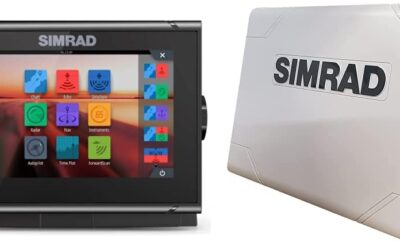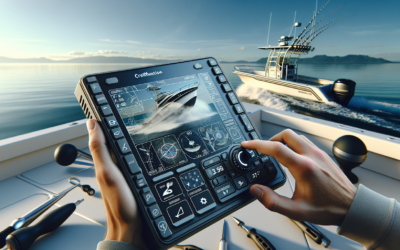You’re about to embark on a deeply informative journey through the intricacies of Traditional and CHIRP Sonar. This piece is all set to demystify the differences between the two types of sonar technology. While both technologies serve similar purposes, they have key differences in terms of how they operate and the level of detail they provide. Get ready to explore the contrasts, applications, and benefits of each, which will help you choose what best suits your specific needs. Here’s your passport to a better grasp on sonar advancements.
Understanding Traditional Sonar
Before we delve into the specifics, it’s crucial that you understand what traditional sonar is. Sonar, an acronym for Sound Navigation and Ranging, is a system that uses the propagation of sound to detect objects under water. It became a vital tool during the world wars for detecting submarines. Today, fishing enthusiasts use it to locate schools of fish.
The Basics of Traditional Sonar
Traditionally, sonar operates by emitting a sound wave through the water. When this wave meets an object (like fish or the seabed), it bounces back towards the source. The sonar system then measures the time taken for the echo to return and determines the distance of the object from the source. This information can be used to create a picture of the underwater environment.
How Traditional Sonar Works
The operational concept is simple. A transducer sends a sound wave into the water periodically. Once the sound wave hits a physical body, it reflects back to the transducer. By calculating the time it takes for the sound wave to bounce back, the sonar system gauges the body’s distance. The frequency of the wave is directly related to the range and resolution of the sonar – a higher frequency provides better resolution but has limited range.
Advantages of Traditional Sonar
You can rely on traditional sonar for a stable, straightforward operation. It’s ideal for elevating the general sea-bottom contour and detecting massive underwater structures. Plus, it offers a high-refresh rate that ensures your readings are up-to-date. Also, a traditional sonar system tends to be more reasonably priced compared to other types.
Disadvantages of Traditional Sonar
While traditional sonar systems offer many advantages, they are not flawless. For one, they don’t offer the detailed resolution you get with higher frequency systems. This means that the image quality isn’t as clear, which could affect your ability to interpret what’s below the water. Further, the range is somewhat limited, particularly in deeper waters.
Understanding CHIRP Sonar
With traditional sonar behind us, let’s explore the world of CHIRP sonar. CHIRP stands for Compressed High-Intensity Radar Pulse. This advanced sonar technology has revolutionized the fishing and boating industry due to its detailed imaging and depth penetration.
What is CHIRP Sonar?
CHIRP sonar, unlike traditional sonar that sends out a single frequency, transmits a prolonged pulse that ranges from low to high frequencies. This technology allows for more energy to be put out into the water for much greater detail and resolution.
How CHIRP Sonar Works
CHIRP sonar works by converting electrical energy into sound waves, just like the traditional sonar, but the magic really happens with the type of pulse it sends out. Instead of sending out just one frequency at a time, it emits a continuous sweep of frequencies. This sweeping pulse allows for greater clarity because the return echoes are converted into a highly detailed, immensely clear picture of the underwater landscape.
Advantages of CHIRP Sonar
The significant appeal for CHIRP sonar is its enhanced resolution and range. It allows for highly-detailed imaging, better target detection, and the ability to see through bait and plankton clouds. You’re also getting a broader view of the underwater elements with CHIRP sonar.
Disadvantages of CHIRP Sonar
CHIRP offers excellent resolution and range, but it does come with a few drawbacks. Primarily, it’s more complex to use and substantially more costly than traditional sonar systems.
Key Differences Between Traditional and CHIRP Sonar
Frequency Range and Usage
Traditional sonar operates at fixed frequencies of 200 kHz or 50 kHz, making it restricted in its operation. On the other hand, CHIRP technology sweeps across a range of frequencies, typically between 28 kHz and 210 kHz, offering broad coverage and higher resolution data acquisition.
Resolution and Accuracy
The single-frequency pulse of traditional sonar limits its resolution and accuracy. CHIRP sonar, by utilizing a broad frequency range, delivers intricate details with superior target separation, making it easier to distinguish between underwater features, such as fish and structures.
Depth Penetration
Depth detection is another area where CHIRP sonar outshines the traditional type. Traditional sonar, with its high-frequency use, can have trouble reaching and accurately reading deep water depths, whereas CHIRP sonar, with its lower base frequency, can penetrate deeper water with high precision.
Target Separation
Traditional sonar can struggle to separate distinct targets that are close together, especially at greater depths. CHIRP sonar showcases its strength in target separation by providing superior image clarity and target identification, even at greater depths and high speeds.
Comparing Image Quality
The quality of an underwater image depends on many factors, such as water conditions, equipment setting, etc., but the sonar’s frequency has a significant influence on it.
Implications of Sonar Frequency on Image Quality
The higher the frequency, the more detailed images. Traditional sonar systems usually operate on a single, fixed high frequency, providing sharp but somewhat limited images. In contrast, CHIRP sonar, with its prolonged pulse covering a range of low to high frequencies, can deliver highly detailed, broader images.
The Superiority of CHIRP’s Broadband Frequency
Traditional sonar can’t compete with the image quality that CHIRP sonar provides. Thanks to its broadband frequency sweep, CHIRP’s imaging capabilities are second to none. The high-definition images generated by CHIRP sonar improve your chances of identifying objects and making more accurate decisions while out on the water.
Exploring Range and Depth Capabilities
Maximum Depth Capabilities of Traditional Sonar
Traditional sonar operates at high frequencies, which produce great detail but are absorbed quickly in water and thus have limited depth penetration. Typically, traditional sonar is effective up to around 600 feet.
CHIRP’s Enhanced Depth Penetration
CHIRP sonar, on the other hand, has greatly enhanced depth penetration due to its range of frequencies. It can penetrate depths of 10,000 feet or more, making it an exceptional tool for deep ocean applications.
Impact of Water Conditions on Range and Depth
Water conditions, including temperature, salinity, and turbulence, can dramatically affect both the range and depth capabilities of sonar systems. Generally, CHIRP sonar copes better with varying water conditions thanks to its wider frequency range.
Understanding Sonar Frequencies
Traditional Sonar Frequencies
Traditional sonar systems use two main frequencies – 50 kHz for deep water and 200 kHz for shallower water. These frequencies serve to churn out a steady stream of consistent, high-frequency sound waves that provide clear readings of a somewhat restricted area.
The Broadband Frequency Spectrum of CHIRP
In contrast, CHIRP can produce a range of frequencies, typically between 28 kHz and 210 kHz. This frequency sweep, effectively a ‘sonic rainbow,’ allows flawless clarity and definitive fish target separation, so you can view more elements underwater than with any other sonar, and see them more distinctly.
The Role of Sonar in Fish Detection
How Traditional Sonar Detects Fish
Traditional sonar can detect fish by sending out high-frequency sound waves that bounce off any solid objects, including fish. When a wave hits a fish, the system records the time it took for the echo to return, which can help identify the depth at which the fish is located.
CHIRP’s Advanced Fish Detection Capabilities
The advanced frequency-modulated pulse of CHIRP sonar allows it to provide detailed information about fish size, shape, and species. The use of lower frequencies provides enhanced depth penetration, making it a powerful fish finder in deep waters.
Transducers in Traditional and CHIRP Sonars
How Transducers Work in Traditional Sonar
In traditional sonar, transducers convert electrical energy into sound waves that are sent down into the water. They also receive the returned echo and convert it back into electrical signals to be processed by the sonar system.
Complexities of CHIRP Transducers
CHIRP transducers function similarly but are far more intricate. They need to handle a sweeping range of frequencies and bring all that complex data together to produce the detailed imagery that makes CHIRP sonar so valuable.
Assessing the Cost Factor
Cost of Traditional Sonar Systems
Traditional sonar systems are generally more affordable than CHIRP systems due to the lower complexity of their operation. They serve as an excellent option for those on a tight budget.
Investment Required for CHIRP Systems
While CHIRP systems are pricier, the superior imaging, extended depth range, and detailed fish detection they offer may justify the added cost for serious anglers or commercial operators.
Choosing the Right Sonar System for Your Needs
Now that you’re familiar with the specifics of traditional and CHIRP sonars let’s look at how to choose the right one for your needs.
Factors to Consider When Choosing a Sonar System
When choosing between a CHIRP and traditional sonar, consider factors such as your typical fishing environments, your level of boating expertise, and your budget.
When to Choose Traditional Sonar
Traditional sonar would work well for you if you’re on a tight budget, are a casual angler, or do most of your fishing in shallow water.
When to Choose CHIRP Sonar
If you’re reading the waters at great depths, targeting specific species, or are a professional angler, investing in a CHIRP sonar system could be a worthy decision. Even though it’s pricier, you’re likely to appreciate the advanced features and detail that CHIRP offers.
In the end, the choice between traditional and CHIRP sonar really comes down to your individual needs, preferences, and budget. Both have their pros and cons, and understanding these can help you make an informed decision.









